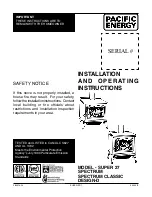
Section 6.5 - Re-fuelling the fire - User instruction
6.5
When refuelling the stove, follow the procedure as detailed below :-
6.5.1
Open the primary air vent to the fully open position.
6.5.2
Add up to 1.5kg of wood or mineral fuel.
6.5.3
After approximately 2 minutes or when the flames from the fresh fuel are fully
established, close the primary air vent.
6.5.4
At high power output your stove will require re-fuelling approximately every hour.
6.5.5
Do not leave the stove until the newly added fuel is well established.
6.5.6
Always refuel onto hot embers and riddle at each refuel.
6.5.7
If the fire has died out at the point of refuelling use kindling to re-establish the
fire.
6.5.8
DO NOT OVERLOAD THE STOVE WITH FUEL.
6.5.9
Reduced burn rates can be achieved via use of the primary and secondary air
controls.
6.5.10
This stove is suitable for intermittant burning and should not be used constantly
for extended periods. Not suitable for overnight burning.
6.5.11
During certain atmospheric conditions it may be difficult to achieve the required
flue draught. If such conditions occur it may require a specialist cowl on the
chimney to achieve the correct flue draught to ensure correct operation of the
stove. In such circumstances do not use the stove and obtain expert advice.
6.5.12
In the event of a chimney fire, close the primary and secondary air controls to the
stove, evacuate the building and call the fire brigade.
Section 6.6 - Maintenance - If in doubt contact a competent person
6.6
Regular cleaning and maintenance of the stove is essential for safety and
efficiency. Flavel recommend a suitably qualified (HETAS) registered engineer is
used for servicing purposes. Ensure the following steps are completed regularly :-
6.6.1
The ashpan should be emptied after every use and during use when
refuelling as required.
6.6.2
When the stove is cold, clean out any build of ash or unburnt fuel from the grate,
around the ashpan and in any nooks or crannies of the stove. Complete monthly
as a minimum, including on top of the stove throat plate, see section 8.
6.6.3
The flue, flue pipe and chimney will require regular sweeping to minimise the
build up of soot and tar, annually as a minimum. The stove should of been
installed with suitable access doors in the flueway to achieve this. However in the
event that suitable access doors have not been installed access to the flue can be
achieved by removal of the throat plate in the stove itself, see section 8.
6.6.4
If the stove door glass is stained, it may be that the secondary air control may
need to be opened up during use, this is dependent upon many factors such as
flue pull etc. In the event of excessive staining use a ceramic glass cleaner to re
move the marks when the stove is completely cool.
6.6.5
Note that the internal boards of the stove will craze with normal use, this is not a
fault of the boards. Cracks will not adversly affect the stove’s performance
providing the boards remain in position. If pieces break from the boards then
replace the boards as necessary. You can significantly increase the life of the
boards by burning the correct fuels in the stove as detailed in section 4 for wood
fuels and section 5 for mineral fuels.
Page 13 of 18




































